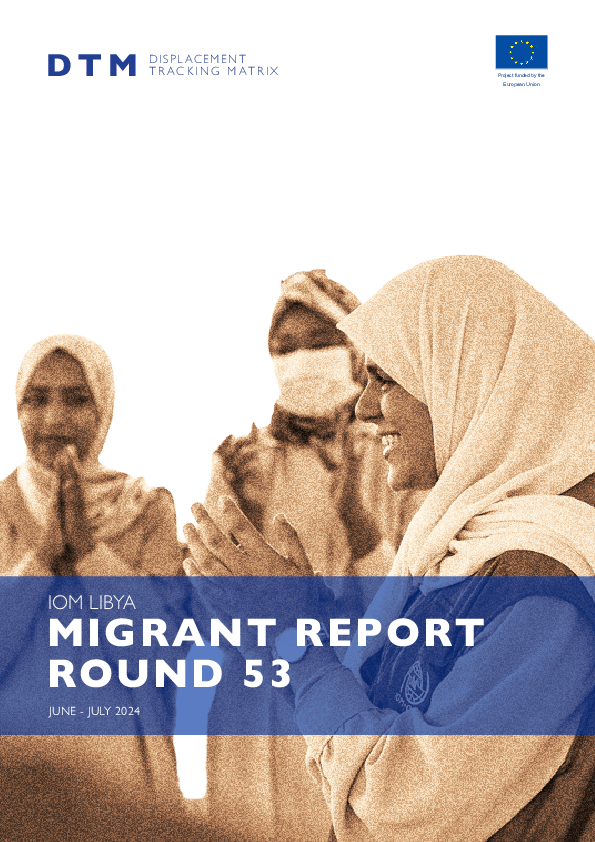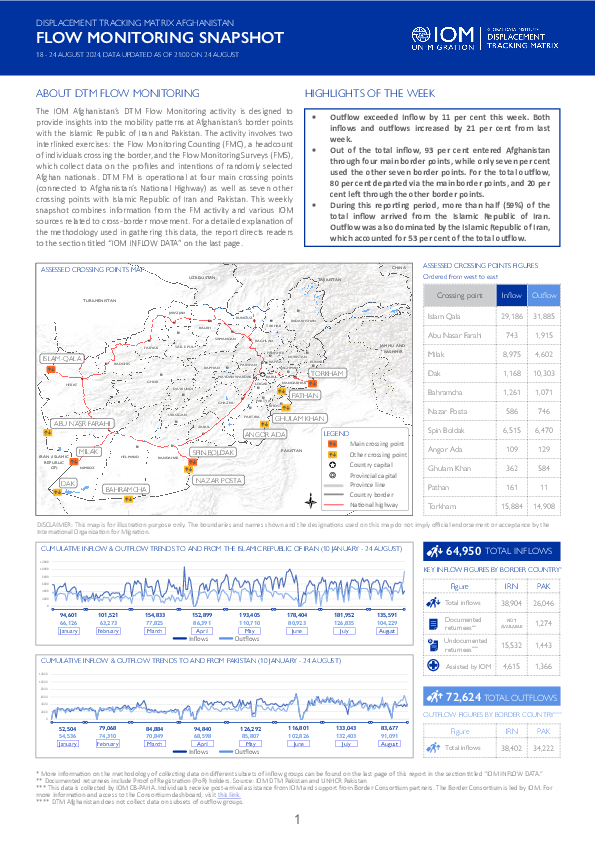-
Countries
-
Data and Analysis
-
Special Focus
-
Crisis Responses

Contact
DTM Europe, DTMMediterranean@iom.int
Language
English
Location
Poland
Period Covered
Apr 01 2024
Apr 30 2024
Activity
- Survey
- Flow Monitoring
IOM’s Displacement Tracking Matrix (DTM) collected data on Ukrainian nationals and Third-Country Nationals (TCNs) who crossed back to Ukraine from Poland, either for a temporary stay or permanent return after a period of displacement abroad. The survey focuses on the return intentions, duration of displacement, destinations, assistance, and experiences of discrimination of respondents. A total of 215 surveys were collected between April and June 2024, all of which were completed by Ukrainian nationals. Consequently, the analysis presented in this
report is solely based on the responses.
Key findings:
- 66% per cent of respondents were returning for a short-visit, 20% were prospective returnees and 14% were unsure
- Top countries of stay: Poland (45%), Germany (22%), Czechia (13%)
- Oblasts of origin: 60% from City of Kyiv, Dnipropetrovska, Zaporizka, Kharkivska, Odeska
- 85% of respondents were returning to their oblast of the origin
- 65% received aid while abroad
- Top 5 needs: safety (41%), financial support (35%), information (21%), health (21%) and medicine (19%)
Contact
dtmlibya@iom.int
Location
Libya
Activity
- Mobility Tracking
- Baseline Assessment
Period Covered
Jun 01 2024 -Jul 31 2024
Libya Migrants baseline assessment and flow monitoring Round 53 Dataset
Population Groups
Migrants Present
Survey Methodology
Unit of Analysis Or Observation
Admin Area 2
Admin Area 3
Admin Area 4
Individual
Type of Survey or Assessment
Key Informant
Keywords
Geographical Scope Full Coverage
Administrative boundaries with available data
The current dataset covers the following administrative boundaries

Contact
DTM Libya, DTMLibya@iom.int
Language
English
Location
Libya
Period Covered
Jun 01 2024
Jul 31 2024
Activity
- Mobility Tracking
- Baseline Assessment
IOM Libya’s Displacement Tracking Matrix (DTM) programme identified a total of 761,322 migrants from 44 nationalities in the 100 Libyan municipalities during round 53 of data collection (June - July 2024).
The number of migrants in Libya has continued to increase slightly (+5%) compared to the previous round of data collection in line with a trend that started in December 2023. The rise in the number of migrants in Libya can be at least partially linked to the continuous arrival of Sudanese migrants, particularly in Alkufra, because of the ongoing conflict in their country of origin. While the number of migrants identified by DTM Libya in July 2024 is the highest since DTM started collecting data in 2016 it remains lower than prior to the onset of conflict in 2011 when it was estimated to be around 2.5 million.

Contact
DTM Libya, DTMLibya@iom.int
Language
English
Location
Libya
Snapshot Date
Jul 31 2024
Activity
- Flow Monitoring
- Mobility Tracking
- Baseline Assessment
This infographic presents the key findings of Round 53 of the mobility tracking and flow monitoring components of the Displacement Tracking Matrix (DTM) programme in Libya.

Contact
DTM Europe, DTMMediterranean@iom.int
Language
English
Location
Latvia
Period Covered
Mar 01 2024
Apr 30 2024
Activity
- Survey
- Flow Monitoring
From 11 March to 30 April, IOM’s Displacement Tracking Matrix (DTM) in Latvia interviewed 41 individuals as part of the Crossing Back Survey. The results from these interviews are presented in the following pages. This survey presents findings on assistance, length of stay and destinations of refugees from Ukraine who intended to travel through the Russian Federation to reach occupied areas in Ukraine.
Key findings:
- 41 Ukrainian respondents: 78% women, 22% men.
- Top oblasts of residence: Donetska (36%), Kharkivska (15%), Luhanska (15%), Zakarpatska (15%), Zaporizka (7%).
- Main countries of stay: Poland (63%), Norway (34%), Germany (3%).
- Reasons to return to Ukraine: meeting family (76%), helping family (11%), homesickness (10%), reunification (3%).
- Immediate needs upon return: financial support (88%), food supply (56%), health services (17%), medicines (15%), clothes and shoes (12%),communication services (12%).

Contact
DTM Somalia, IOMSomaliaDTM@iom.int
Language
English
Location
Somalia
Period Covered
Aug 24 2024
Aug 27 2024
Activity
- Mobility Tracking
- Baseline Assessment
This latest round of Emergency Trends Tracking was initiated in April 2024 to monitor displacements movements during the Gu rainy season. Districts covered in this round include Afgooye, Afmadow, Baardheere, Baidoa, Balcad, Belet Weyne, Belet Xaawo, Cabudwaaq, Dayniile, Dhuusamarreeb, Doolow, Gaalkacyo, Garoowe, Hodan, Jamaame, Jowhar, Kahda, Kismaayo, and Luuq. ETT is a crisis-based tool that tracks sudden displacement triggered by specific events or emerging crises.
The objective of ETT is to help prioritize humanitarian response and to enable partners to deliver rapid assistance. Based on previous shock induced displacement patterns, the humanitarian community expects that people will continue to move toward urban areas in search of humanitarian services. Consequently, the ETT coverage focuses on the main urban centers and surrounding villages for each assessed district. The data is collected through Key Informant Interviews (KIIs) at the location level, from Sunday to Wednesday every week. It includes information on new arrivals, numbers and demographic of IDPs, reasons for displacement, intentions, humanitarian assistance and priority needs among others.
To facilitate the joint analysis of the CCCM (Camp Coordination and Camp Management) Cluster’s New Arrivals Tracker (NAT) and ETT data, the assistance and needs indicators are identical in both tools.

Contact
DTM Europe, DTMMediterranean@iom.int
Language
English
Location
Republic of Moldova
Period Covered
Apr 01 2024
Jun 30 2024
Activity
- Survey
The IOM’s Displacement Tracking Matrix collected data through Surveys with Refugees in the Ukraine Response region from April to June 2024. In the Republic of Moldova, a total of 1,892 surveys were collected. This report focuses on the characteristics, socio-demographic composition, challenges, and needs of the displaced population in the Republic of Moldova, with a particular emphasis on healthcare and the medical needs of the respondents.
Key findings:
- 43% of respondents have or live with people with specific needs or serious medical conditions, while 5% reported living with a pregnant or lactating women.
- Main health issues for women include chronic disease or serious medical conditions (41%), visual impairment (18%), difficulty walking (13%), and hearing impairment (6%).
- Main health issues for men include chronic disease or serious medical conditions (53%), visual impairment (17%), difficulty walking (15%), and hearing impairment (7%).
- Health related needs reported by the respondents include medication (41%), health services (38%), and mental and psychosocial support (2%).
- The most reported barriers to accessing health care were costs (57%), long queues (33%), unavailable services (19%), language barrier (18%), and lack of documents (10%).
Contact
DTM Yemen, iomyemendtm@iom.int
Location
Yemen
Activity
- Mobility Tracking
- Event Tracking
Period Covered
Aug 25 2024 -Aug 31 2024
From 1 January to 31 August 2024, IOM Yemen DTM tracked 2,319 households (HH) (13,914 Individuals) who experienced displacement at least once.
Between 25 and 31 August 2024, IOM Yemen DTM tracked 40 households (240 individuals) displaced at least once. The majority of people moved into/within the following governorates and districts:
- Ma’rib (26 HHs) – Ma’rib City (21 HHs), Ma’rib (4 HHs), Raghwan (1 HH) districts. Most displacements in the governorate originated from Ta’iz and Al Hodeidah.
- Al Hodeidah (9 HHs) – Al Khukhah (7 HHs), Hays (2 HHs) districts. Most displacements in the governorate originated from Al Hodeidah and Ta’iz.
- Ta’iz (5 HH) – Al Makha (4 HHs), Al Misrakh (1 HH) districts. Most displacements in the governorate originated from Al Hodeidah.
The majority of people moved from the following governorates and districts:
- Al Hodeidah (16 HHs) – At Tuhayta (4 HHs), Hays (4 HHs), Al Jarrahi (2 HHs) districts.
- Ta’iz (6 HHs) – At Taiziyah (2 HHs), Maqbanah (2 HHs), Al Makha (1 HH) districts.
- Al Mahwit (4 HHs) – At Tawilah (2 HHs), Melhan (2 HHs) districts.
Population Groups
IDPs
Returnee (Previously Internally Displaced)
Survey Methodology
Unit of Analysis Or Observation
Admin Area 2
Household
Type of Survey or Assessment
Household
Key Informant
Keywords
Geographical Scope Partial Coverage
Administrative boundaries with available data
The current dataset covers the following administrative boundaries

Contact
DTM Yemen, iomyemendtm@iom.int
Language
English
Location
Yemen
Period Covered
Aug 25 2024
Aug 31 2024
Activity
- Mobility Tracking
- Event Tracking
IOM Yemen DTM's Rapid Displacement Tracking (RDT) tool collects data on estimated numbers of households forced to flee on a daily basis from their locations of origin or displacement, allowing for regular reporting of new displacements in terms of estimated numbers, geography, and needs. It also tracks returnees who returned to their location of origin.
From 1 January to 31 August 2024, IOM Yemen DTM tracked 2,319 households (HH) (13,914 Individuals) who experienced displacement at least once.
Between 25 and 31 August 2024, IOM Yemen DTM tracked 40 households (240 individuals) displaced at least once. The majority of people moved into/within the following governorates and districts:
- Ma'rib (26 HHs) – Ma'rib City (21 HHs), Ma'rib (4 HHs), Raghwan (1 HH) districts. Most displacements in the governorate originated from Ta'iz and Al Hodeidah.
- Al Hodeidah (9 HHs) – Al Khukhah (7 HHs), Hays (2 HHs) districts. Most displacements in the governorate originated from Al Hodeidah and Taiz.
- Taiz (5 HH) – Al Makha (4 HHs), Al Misrakh (1 HH) districts. Most displacements in the governorate originated from Al Hodeidah.
The majority of people moved from the following governorates and districts:
- Al Hodeidah (16 HHs) – At Tuhayta (4 HHs), Hays (4 HHs), Al Jarrahi (2 HHs) districts.
- Ta'iz (6 HHs) – At Taiziyah (2 HHs), Maqbanah (2 HHs), Al Makha (1 HH) districts.
- Al Mahwit (4 HHs) – At Tawilah (2 HHs), Melhan (2 HHs) districts.
IOM identified 45 additional households displaced in the previous reporting period, which covered 18 - 24 August 2024, in the governorates of Al Hodeidah (25 HHs), Ta'iz (18 HHs), and Ma'rib (2 HHs). These figures have been added to the cumulative displacement total recorded since the beginning of the year.

Contact
DTMAfghanistan@iom.int
Language
English
Location
Afghanistan
Period Covered
Aug 18 2024
Aug 24 2024
Activity
- Survey
- Flow Monitoring Survey
- Flow Monitoring
The IOM Afghanistan’s DTM Flow Monitoring activity is designed to provide insights into the mobility patterns at Afghanistan’s border points with the Islamic Republic of Iran and Pakistan. The activity involves two interlinked exercises: the Flow Monitoring Counting (FMC), a headcount of individuals crossing the border, and the Flow Monitoring Surveys (FMS), which collect data on the profiles and intentions of randomly selected Afghan nationals. DTM FM is operational at four main crossing points (connected to Afghanistan’s National Highway) as well as seven other crossing points with Islamic Republic of Iran and Pakistan. This weekly snapshot combines information from the FM activity and various IOM sources related to cross-border movement. For a detailed explanation of the methodology used in gathering this data, the report directs readers to the section titled “IOM INFLOW DATA” on the last page.
